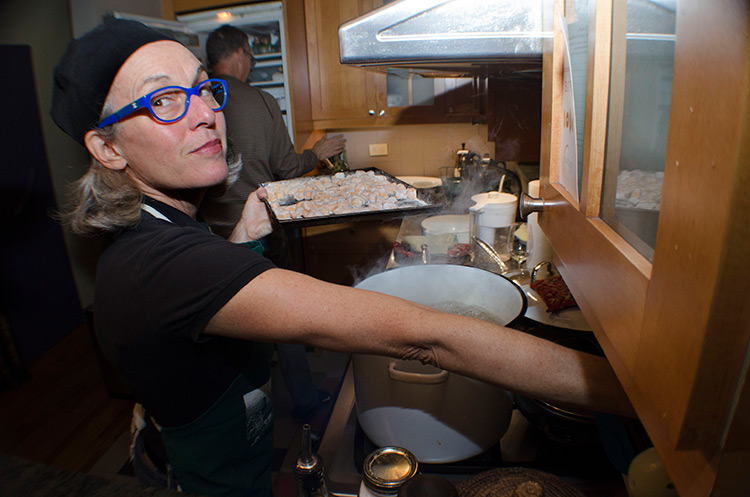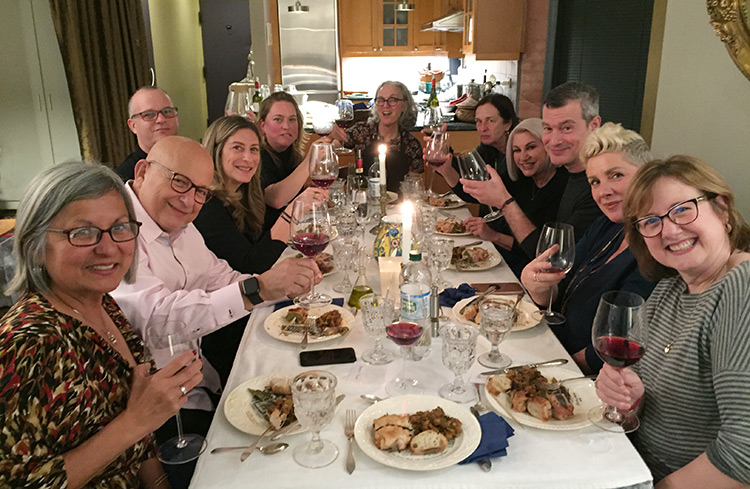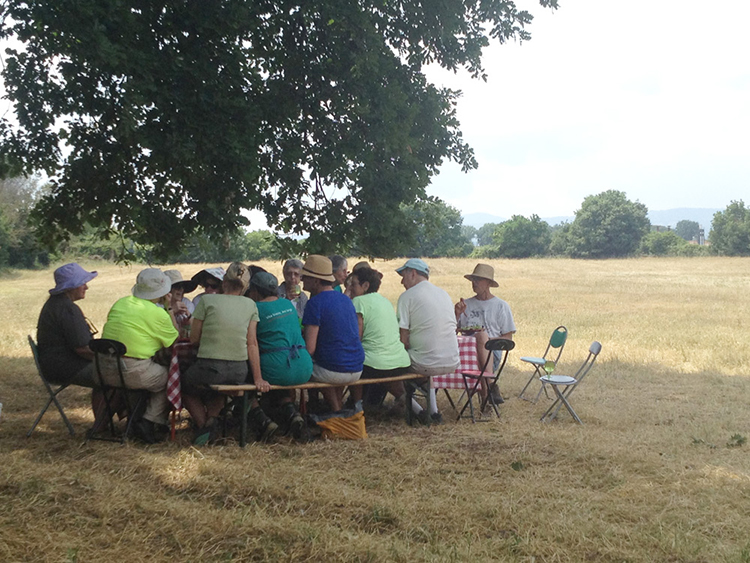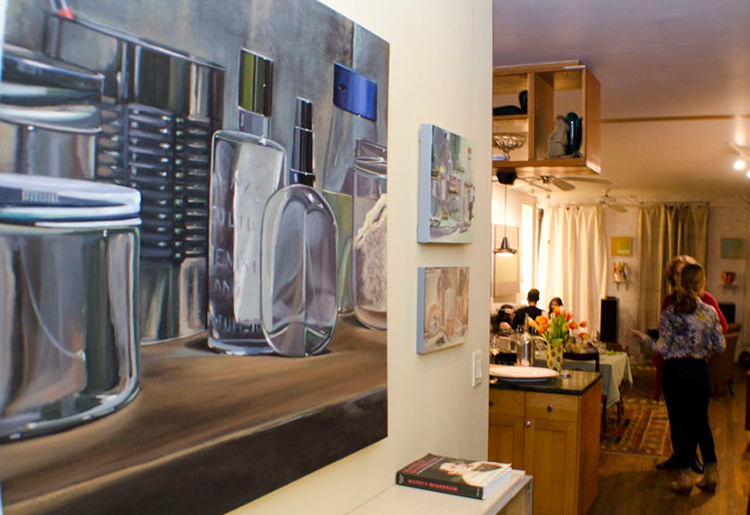ENTER YOUR EMAIL TO RECEIVE OUR WEEKLY NEWSLETTER
Dining with Strangers in their Home
Shared-economy alternatives to restaurant meals are a quick way of making new friends—no tips required
By Maddine Insalaco

One Potato Two Potato. The author at it in her kitchen. Those are sweet potato gnocchi in the pot and on the pan.
. . . . . . . . . . . . .
July 22, 2022
Dinner for ten, at a stranger’s apartment or private home, seated with other strangers? Welcome to the world of social dining. The culinary analog of Airbnb, this international phenomenon has evolved along with other activities in the so-called shared economy. Internet platforms mediate between chef hosts, both self-styled and professional, who offer culinary experiences, and their would-be guests. When planning a trip to New Orleans, Barcelona, or Rome, for example, instead of dining at a restaurant you book a meal in a private home. These “events” usually have a fixed number of seats at the table, and sign-up is open. Among other benefits, guests have first-hand access to valuable insiders’ information from hosts about where to go—which can help them avoid tourist traps and instead experience the city in a meaningful way. And then there’s the opportunity of meeting others in a welcoming environment to share stories and have a good time.
Conceived as a service to world travelers eager for authentic interactions with residents of the city they’re visiting, social dining provides benefits to local participants as well—especially those seeking an alternative to restaurant dining. Prices for a multicourse meal, often with wine included, are often lower than at a restaurant and are paid on booking, with no money exchanged at the event; nor are tips or gratuities expected. In Rome, for example, a Tiber-side lunch featuring appetizers, pasta, dessert, and local wine can run for as little as $28. A 4-course seafood dinner, also with wine, can be had for about $64.
Prices and menus are determined by hosts. A percentage of the fee is deducted by the listing platform. Typically, the site will list the event and menu description, a host profile, reviews, and basically whatever information the host would like to share with potential guests. Hosts can be contacted with questions and special requests before booking. The process is straightforward and user-friendly.
Each meal is prepared for a specific event, which means it is fresh and genuine. The small production scale also guarantees quality. And the fact that there is usually one table offers an exclusivity impossible in a restaurant. For the many New Yorkers accustomed to eating in noisy restaurants, dining in a private home offers the chance to enjoy and participate in conversations.
What’s more, in many locations hosts will arrange private parties—in effect, small-scale catering—upon request, with advanced planning. This presents a perfect alternative for those with busy schedules or who suffer dinner-party angst and want to host friends or family without the stress—at an affordable price.

Cheers! An Eatwith dinner for 12 at Maddine Insalaco and Joe Vinson’s New York apartment.
. . . . . . . . . . . . .
Operating in more than 130 countries, with 150,000 members and counting, Eatwith.com is the world’s largest platform for culinary experiences. Unlike competitors Airbnb and Trip Advisor, Eatwith is concerned exclusively with food. According to Lauren Timmer, its content and social media marketing manager, “The dining table is the original social network. Our purpose at Eatwith is to bring people together through the universal language of food.” Timmer sees participation in event offerings as a kind of adventure that harkens back to former times when travelers met at tables in public houses and inns and exchanged their stories. Eatwith “experiences” are carefully curated by hosts to reflect their particular messages, which in all cases communicate a sense of generous hospitality. This results in a hugely diverse range of gastronomic offerings.
The biggest Eatwith markets in the U.S. are New York and California—mainly San Francisco and Los Angeles. New York City alone has more than 70 hosts, many of whom have multiple menu offerings. The New York-based U.S. Community Manager, Luciana Lamboy, reports that approximately half the local hosts are located in Brooklyn, with another 30 percent in Manhattan.
Becoming an Eatwith host today is easy and limited only by the ability to deliver a quality meal in an interesting venue within an organized time frame. Chefs do this by profession, but anyone who is confident of her or his cooking skills can apply to be part of the platform. The process is clearly described on the Eatwith website.
But why decide to host? For one thing, there’s the chance for supplementary income. This varies according the menu and the cost of ingredients—but is completely under control of the host. Experience will show which price points generate the best results. What’s more, for anyone with a culinary gift looking to expand a social network, this can be a way of building new relationships. And hosting provides a good opportunity to build a client base for the promotion of other activities.
That is what led me to become a New York host several years ago. I was introduced to Eatwith in 2014 by an attendee at the landscape painting class I was teaching with my husband, Joe Vinson, in Tuscany, where we live for six months each year. Among the popular features of our classes are the plein air lunches we prepare and serve in stunning landscapes—where we are often the sole humans present. Noting the quality and variety of the menus, combined with our long experience working with groups in Italy, that participant suggested we become Eatwith hosts. I had never heard of social dining but found the concept intriguing and looked into it.

Mangia tutti mangia! One of the author’s plein air lunches in the Roman Campagna in the Lazio region, Italy.
. . . . . . . . . . . . .
As artists with limited resources and unpredictable income, we are constantly seeking alternative ways to stabilize our earnings and promote the classes and gastronomic tours that we run in Italy. It became clear that becoming Eatwith hosts was not only an opportunity to accomplish that, but also to showcase our art, which we display on the walls of our Lower East Side, New York apartment. So after developing menus, organizing our presentation, and jumping through the required hoops, we became Eatwith hosts, offering a series of dinner menus collectively billed as “The Artist Palate.”
The culinary experiences presented on the Eatwith platform in New York are widely varied. There are dinners with multiple courses, many of which are ethnic and reflect the mosaic of populations living in the city. For example, longtime host Ai, in Brooklyn, offers a six-course seafood tasting menu from her native Japan which includes vegetables and herbs grown on her rooftop garden. Numerous cooking classes offer the curious gastronome the opportunity to learn something new and different. On Manhattan’s Upper East Side, Diego hosts a Peruvian Ceviche workshop for small groups. Then there are the novelty experiences that resist categorization, like that of Uluc Ulgen, alias Dr. Honeybrew—who prepares Turkish coffee fortune readings in the East Village. At Eatwith, there is something for everyone.
We have been hosting these dinners in New York since 2015, resuming our activities this past winter after a pandemic pause and just before transferring to Italy again. Among the various guests we welcomed to our table were an interior designer from Long Island, a Manhattan cardiologist, and a hair salon owner from Minnesota. All of them brought friends, spouses, or grandchildren to experience our “Italian Unification” menu—an unorthodox pairing of dishes and wines from north and south in the same meal. Featured were hand-rolled and -cut buckwheat pasta “Pizzocheri” from the Alps, served with a Sicilian Grillo for the first course, followed by stuffed chicken “involtini” and caponata from Sicily with a Valtellina Superiore. For dessert, a southern spin was placed on the Central Italian classic tiramisu by blending pistachio cream from Bronte on Mount Etna with mascarpone. Altogether labor intensive for sure, but the happy faces and clean plates we collected afterwards made it worth the effort.

Artful dining. Maddine and Joe showcase their paintings on the walls of their New York apartment while hosting one of their social dining events.
. . . . . . . . . . . . .
It continues to surprise me that the majority of our guests had never heard of social dining before and were joining an Eatwith event for the first time. From what I could observe as a host, guests are universally enthusiastic about their experiences and plan to repeat them. In the rarified atmosphere of a private home with good food and wine to loosen reserve, conversation comes easily. The positive vibe of the relaxed setting is conducive to spontaneous connection, naturally and effortlessly. And New York is such a hectic town, with everyone in a hurry, that many of its residents welcome time-outs and new experiences beyond their usual dining and socializing spots.
What’s not surprising is that the user and host market of this internet-based activity is comprised primarily of young people between 25 and 40 years old, with women the most active participants. But that shouldn’t deter older generations, who, after all, have more years of experience both cooking and dining—and may very well have accumulated some amazing home furnishings and tableware to show off. In fact, a social dining experience is a perfect opportunity for those in the older segment of the population to try something new and meet people in a comfortable, intimate venue with low emotional risk.
There is so much to gain by allowing the forces of the unknown to work their magic among a random arrangement of people at a table. So much of our lives are mediated, scripted, and organized these days that little room is left to chance anymore. And yet it is in those unexpected, casual, and random moments that life in its most meaningful form just happens. That is the real adventure of social dining.
. . . . . . . . . . . .
Maddine Insalaco is a painter who divides her life between New York and Tuscany, where she organizes landscape painting workshops and gastronomic tours with her artist husband. An authority in the field of early open air painting, she has published, lectured, and curated museum exhibitions on related subjects in the USA and Italy. Instagram: @maddine_insalaco.
You may enjoy other stories in NYCitywoman:











